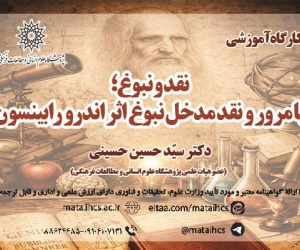انواع تمثیل در ادبیات مانوی (مقاله علمی وزارت علوم)
درجه علمی: نشریه علمی (وزارت علوم)
آرشیو
چکیده
تمثیل ها و حکایت ها دستاوردهای ادبی بی نظیر ادبیات مانوی در آسیای مرکزی است. مانی به درستی از ارزشمندی داستان ها، در انتقال حقایق و مفاهیم آگاه بوده و همین امر سبب ایجاد ادبیات تمثیلی مانویان شده است. مانویان داستان سرایان بسیار زبده و چیره دستی بودند که برای بیان حقایق پنهانی این داستان ها را به صورت قصه بازگویی کردند. تمثیل در ادبیات مانوی به یک شیوه خاص تبدیل شده است. در این مقاله به بررسی گونه های مختلف آن در این نوع خاص ادبیات مانوی پرداخته ایم. مانویان از هنرهای چندگانه ای چون شعر، داستان، نقاشی، خوش نویسی، تذهیب و موسیقی بهره گرفته اند تا بتوانند آیین و کیش خود را به درستی ترویج و گسترش دهند. با بررسی تمثیل در ادبیات مانوی که یکی از مهم ترین گونه های ادبی در ادبیات مانوی است به این دستاورد رسیدیم که داستان ها و تمثیل های مانوی شامل حکایت های انسان ها و حیوان ها می شوند؛ که به مرورزمان افسانه هایی سرگرم کننده در ادبیات فارسی تبدیل شده اند.The Types of Allegory in Manichean Literature
One of the most important literary figures in Manicheism literature is simile as it was used by the Manichaeans to talk about their hidden truth so that they could properly propagate and spread their religion. Fable and parable are the impressive literary accomplishments of Manicheism literature in central Asia. As a result, in this study, we attempt to study the Manicheism simile and its different kinds used in this kind of literature. To do so, a library-based descriptive analytical approach was used where a summary of a fable is provided followed by its interpretation and a discussion of its morale. In general, a great part of the Manicheism prose written in Iranian languages consists of stories about people (parables) and stories about animals (fables) which were used by the Manicheans as a way to teach their doctrines and propagate their religion. Introduction Simile in literature is mostly used in didactic and fictional literature as a way to explain and interpret ethical and mystical beliefs and has dedicated to itself a great portion of ancient literary works. The discovery of Manichaean literature in Turpan, China, and Faiyum’s (Egypt) expedition, revealed that literary works did not merely belong to the Islamic times; but, by studying Manicheism literature, researchers were able to open up new horizons in Persian literature. Although during the Islamic times, Manichaeans did not have much presence in Iran, their allegorical stories found their way into then-Persian literature and significantly influenced it. In fact, by gathering stories and allegories, and by distributing them to other cultures, Manicheans were able to create one of the most important literary genres; and, unlike Zoroastrians who were not interested in documenting and writing books, Manicheans managed to communicate with other nations’ literature and culture, and began translating and writing books. Method This research can be considered one of the first studies focusing on allegorical texts and their types in Manicheism literature; and to do so, a library-based descriptive analytical approach was used. Discussion Overall, Manicheism prose literature written in Iranian languages occupies a great portion of allegorical literature; nearly all such works, can be considered didactic and ethical works composed in a rhetorical style. Among Manicheism works, this literary genre is replete with rapture and literal and spiritual techniques about Mani and the history of his religion, religious pieces of advice and doctrines, the creation and demolition of the universe, sprits and salvation, Jesus Christ prayers, etc. For instance, in a piece of prose written in Parti language about “Mani’s attempt to convert Turan-Shah to his own religion”, literary enchantments technique was used “to lead Turan-shah into the outer space”. Or in another piece, the allegory of a storm-stricken ship as well as the burglary of the pearls, pieces of jewelry, and the ship cargo, actually refer to the battle of the early man with the beasts, or in other words, representing the imprisonment of human’s soul in their material flesh. The Manicheism prose and allegory remained are in middle Persian languages, Parti and Sogdian languages; and at times, are so concise and succinct that can be phrased in only one sentence; just like the modern-day short stories, and, at times, they are very long and winded; like the allegory of “treat and welcome thy godsent guest with thy godsent food” or the allegory of “the princess who fallen madly in love with a boy”. In fact, in different nations and ethnicities, simile has always had a special place because it could be used as a way to guide people and promote religious doctrines and beliefs. And, this was evinced by those creative Manicheism writers and poets who were not concerned with becoming famous figures in the literature, and whose only goal was to spread their religious doctrines. Since Mani considered his religion better than and superior to other religions, and because literature had a very special and important place among the Manicheans, allegorical literature, too, become Manicheans’ most preferred and highly valued genre of literature. Even over time, Manichaeans’ allegories and stories are now among the entertaining mythical stories in modern Persian literature. Stories that include the fables of humans and animals and that the Manichaeans used them for their instructive and propagational purposes









